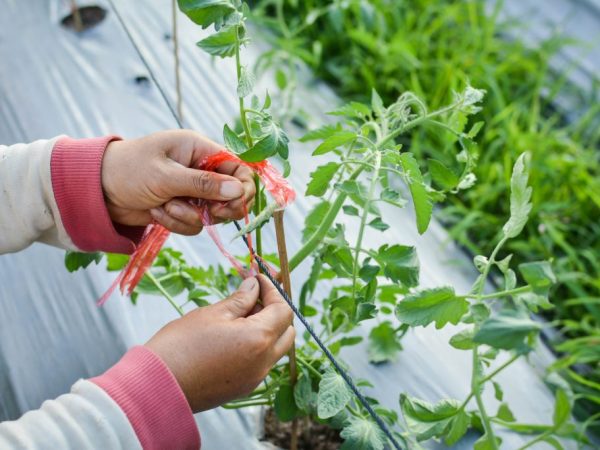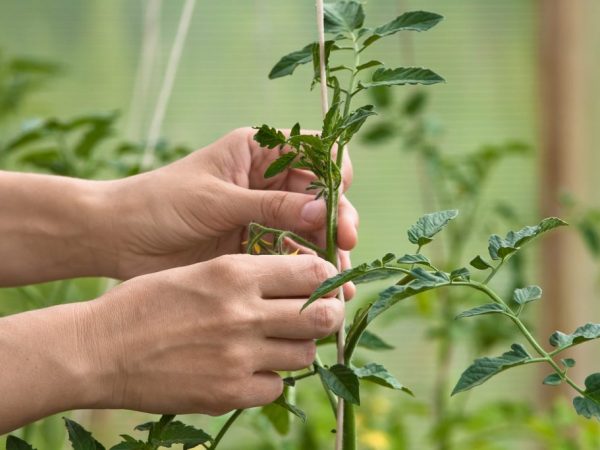Rules for tying tomatoes in greenhouses
Correct planting and maintenance of crops in the greenhouse can increase the amount of the crop. Arranging a tomato planting site saves a person time and resources. Unpretentious varieties of tomatoes grow quickly in a greenhouse and need special care: if you tie up tomatoes in a greenhouse in a timely manner, you can avoid diseases and damage to fruits during ripening.

Rules for tying tomatoes in greenhouses
Why do you need a garter bushes
Experienced gardeners know that tying a crop in a greenhouse doubles the amount of the crop and improves its quality: all varieties of tomatoes that are planted in greenhouse conditions need decoration. The garter of tall varieties is especially important: under the weight of ripening fruits, green lashes break and begin to rot.
If in the open field tying bushes is not necessary, then for greenhouses such a measure is simply necessary. Low-growing varieties grow well without additional support and even in cramped conditions give a stable harvest, but for them in the greenhouse they also reduce the space with the help of supports. Cucumbers are attached to supports to improve fruiting without additional fertilization and irrigation of the soil. Step-by-step tying requires further care of the plant: cleaning and trimming of excess lashes are mandatory.
Garter features
Tying the bushes makes it easier to care for them: it becomes easier to water and fertilize the root system (in tomatoes, the rhizome is in the upper layers of the soil). The vertical arrangement of the lashes saves space.
For garter lashes are used:
- quality materials;
- cleaned and disinfected stakes and rods;
Wire and rope are not used because they can damage the stem and kill the plant.
After the appearance of stepsons (cucumbers or tomatoes grow in a greenhouse), the bush naturally grows, and fruits are formed on the lashes. Zelentsy rarely ripen, but at the same time they draw out juices from the stem.
Depletion of the root system with minimal watering affects the quality and size of the fruit on the main stem. Grazing is carried out only on a tied plant - an integrated approach to the design of the lashes allows you to get the best harvest.
Growing tomatoes without a garter
If you do not tie cucumbers and tomatoes, the fruits that form on the lower ground lashes ripen unevenly and in most cases rot. The vegetables on the shady side are not marketable and are not used for making marinades or curls. Because of the overgrown lashes, root rot appears. It is dangerous for neighboring healthy crops.
Due to the growing lower lashes during watering, the fruits become contaminated: uneven watering of the plant leads to rotting of green fruits.
Slugs and pests are dangerous for tomatoes lying on the ground.Unformed lashes are susceptible to a disease dangerous for tomatoes - late blight: fungal spores enter the fruit directly from the soil.
What is used for a garter
The garter of tomatoes depends on the conditions in which the seedlings were planted: in a polycarbonate greenhouse, the same methods of decorating the plant are used as in the open field.
How to tie tomatoes in a polycarbonate greenhouse:
- using a cord or tape;
- fiber thread;
- thin tourniquet.
The choice of materials for the garter depends on the time when the formation of the bush takes place. A young plant should not be dragged with wire, otherwise deformed tomatoes of an unmarketable type will appear on the damaged lashes. The scraps of fabric to tie the lashes should not rot, so only high-quality materials are selected. Synthetics demonstrate good strength, but without stretching threads. In order not to bring fungal spores or infection onto the stem, before the garter procedure, the shreds are boiled or soaked in a disinfectant solution.

Garter materials should be disinfected
Purchased clamps help to properly tie up tomatoes in the greenhouse. These are ready-made ribbons made of durable material that do not lose their characteristics within 2-3 months. Tomatoes are tied up neatly, without unnecessary pressure and bending of the main stem. It is necessary to tie up tomatoes in a greenhouse made of durable polycarbonate after one stem has formed and ovaries appear.
Preparing for the procedure
In order to properly tie the stem, a solid support is prepared. This is the main way of fastening the whips during the ripening of the crop. Without a support, they make a temporary attachment for a growing plant, which has neither flowering nor greenery. To fix the lower lashes and the main stem, only high-quality, durable materials are used.
How to tie up tomatoes in a greenhouse correctly? For these purposes, use:
- stakes made of wood;
- metal rods;
- twine for fixing the lashes;
- a mesh made of metal or durable plastic.
One type of fastening material is selected for all crops. If the support is reused, it is treated and disinfected. Without performing such actions, it will not be possible to avoid contamination of greenhouse crops.
Metal parts are cleaned of rust and soil residues. A chlorine solution helps to properly clean the supports from microbes and pathogenic microorganisms. Before the garter, all parts are washed with purified running water.
Purchased clips save the gardener the hassle of finding the right materials. Plastic parts are used to tie the hands with and without fruits. You can re-attach bushes with clips: purchased parts are used multiple times.
Stakes and metal supports
A growing bush can be supported with the simplest support - stakes. For these purposes, a rail or a metal thick rod is used. The plant is tied up with stakes immediately after the first inflorescences appear.
How to tie tomatoes in a greenhouse on slats correctly:
- a rod is driven into the ground near each plant - the distance to the stem is 10 cm (if you place the stakes closer, you can damage the root);
- tomatoes (whip and stem) are neatly attached to the rail with strong twine;
- the rope is located near the top of the bush;
- twine or rope is tied around the stem and rail several times;
- the ends of the rope are tied.
With the help of stakes, stunted bushes with long basal whips are tied up. As the bush grows, the rope moves. To tie up tomatoes, pick up twigs 70 cm longer than the estimated height of the plant.
In greenhouses, rods are installed before planting seedlings: the beds are formed based on the location of the stakes. The first step is to tie up the main stem, and then the side lashes and brushes.
Horizontal garter method
One of the safest ways to tie tall tomato bushes is with a horizontal support. For fastening, tapes are used, which are located at a distance of 1.5-2 m from each other. Tying tomatoes in the greenhouse takes place in stages:
- high stakes are driven in around the entire perimeter of the greenhouse;
- the mount is rammed and covered with soil (the trellises should not stagger or move);
- at a height of 40 cm from the soil level, a processed twine is pulled between the fasteners.
As the bushes grow, the branches are attached to the stretched thread and neatly fixed. For convenience, several ropes are stretched between the trellises in order to fix the bushes as best as possible from different sides.
How to properly tie tomatoes in a greenhouse using trellises? To preserve green fruits, special hooks are used. They do not allow the brushes to weigh down the stem, but they do not stop the flow of nutrients from the stem to the fruit.
Frame and mesh
How to tie tomatoes in a greenhouse and which fasteners are the most reliable? Linear methods of garter bushes include a mesh hedge. The whips are tied with a rope to the upper wire, which is held on to the installed rods. From above, the bush is fixed to the wire, and from below - to the rods. With this method, it is convenient to tie bushes, in which both the upper and lower lashes grow strongly.
On both sides of the garden bed, where the tomatoes are planted, a net is pulled, which is held by stakes located at the same distance from each other. This method can be used to tie up bushes from all sides and at any height. You can tie the lashes to the net with twine or pieces of fabric.
The improved culture tie method is based on the construction of a solid frame. A comfortable structure is entirely made of metal or wood. Each frame is located around the plant, so the garter is carried out at any level and height.


